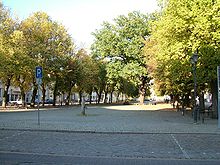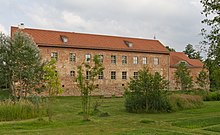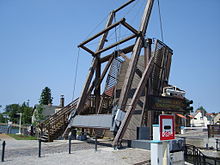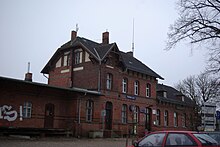Storkow (Mark)
| coat of arms | Germany map | |
|---|---|---|

|
Coordinates: 52 ° 15 ' N , 13 ° 56' E |
|
| Basic data | ||
| State : | Brandenburg | |
| County : | Oder-Spree | |
| Height : | 37 m above sea level NHN | |
| Area : | 180.72 km 2 | |
| Residents: | 9226 (Dec. 31, 2019) | |
| Population density : | 51 inhabitants per km 2 | |
| Postal code : | 15859 | |
| Area code : | 033678 | |
| License plate : | LOS, BSK, EH, FW | |
| Community key : | 12 0 67 481 | |
| City structure: | 14 districts | |
City administration address : |
Rudolf-Breitscheid-Str. 74 15859 Storkow (Mark) |
|
| Website : | ||
| Mayoress : | Cornelia Schulze-Ludwig ( SPD ) | |
| Location of the city of Storkow (Mark) in the Oder-Spree district | ||
Storkow (Mark) ( Lower Sorbian Storkow ) is a city in the Oder-Spree district in Brandenburg .
geography
The town of Storkow (Mark) is located in the western part of the Oder-Spree district. It borders in the north on the Spreenhagen office , in the east on the Scharmützelsee office and the municipality Rietz-Neuendorf , in the southeast on the municipality Tauche , in the south on the municipality Märkische Heide and the Unterspreewald office in the south-west, in the southwest on the office Schenkenländchen and in the west and northwest to the municipality of Heidesee (the latter five territorial units in the district of Dahme-Spreewald). Storkow (Mark) is located on the (Großer) Storkower See , east of the city is the Scharmützelsee , in the south the Unterspreewald and in the west the Dahmeland . In the southeast, the Storkows area extends to the Schwenowsee and Blabbergraben .
City structure
The city of Storkow (Mark) is divided according to its main statute into the core city and the following districts.
- Storkow (Mark) with the residential areas Hubertushöhe, Neu Boston and Wolfswinkel
Districts are:
- Alt Stahnsdorf ( Lower Sorbian Stańšojce ) with the Neu Stahnsdorf residential area
- Bugk (buk)
- Görsdorf / b. Storkow (Górice) with the inhabited part of the municipality Busch
- Groß Eichholz (Dubina) with the living space of the Groß Eichholz colony
- Look great (Sowje)
- Kehrigk (Keŕki) with the residence Tschinka forest house
- Klein Schauen (Małe Sowje) with the Wolziger Straße residential area
- Kummersdorf (Komorow) with the old mill residential area
- Limsdorf (Limšojce) with the inhabited parts of the municipality Möllendorf (Mólin) and Schwenow (Žwěnow) as well as the residential area forester's mill Grubenmühle
- Philadelphia (Skopica) with the Kiesberg residential area
- Rieplos (Rěpkow)
- Schwerin (Zwěrin) with the Kurtmühle residential area
- Selchow (Želchow)
- Wochowsee (Wochow)
history
Place name
Obviously, the name is often associated with the stork (which can often be found in the area with many lakes), and the city's coat of arms shows this animal accordingly. However, as is often the case with old Brandenburg towns, the name actually has a Slavic origin. It goes back to the word Sturkuowe , which means a path through the swamp .
Middle Ages and early modern times
Storkow is the sixth oldest of the 112 cities in Brandenburg (as of May 1, 2007). Two documents, one from May 2nd, 1209 from Margrave Konrad von Landsberg from the House of Wettin and a second from December 26th, 1209 from Emperor Otto IV , prove that they have full city rights . This makes Storkow the first documented town between Dahme and Oder , older than Berlin , Frankfurt (Oder) and Fürstenwalde .
Storkow was on the northern border of Lusatia (or Ostmark , as the region was then called) and on an old trade route that led from Barnim to Lübben and Leipzig . Around 1200 it was the most important settlement in the area. For the Wettin sovereigns, Storkow was of strategic importance in integrating the area into the empire and securing the borders. The location on a narrow passage between the swamp and the lake (area of today's bascule bridge ) and the Storkow Castle, built on a heaped hill after 1136, were among the fortifications of the city. Around 1202, Margrave Konrad appointed the important noble family of Strele as his agents, who were owners of the Beeskow and Storkow estates until 1382 .
The Wettin rule of Storkow was the largest and most important in Lusatia around 1200. It reached from Baruth in the west to Sternberg east of the Oder and Reichwalde near Luckau in the south. Parts of Senftenberg and Fürstenberg were also temporarily owned by Strelesch. Six cities, five castles, around 60 villages of different sizes, numerous rivers, lakes, forests and fields belonged to the rule. After the Strele died out, the Lords of Biberstein owned the town and castle of Storkow from 1384 to 1518. Heavily indebted, they pledged the Storkow / Beeskow rule to the rich bishops of Lebus, who had their bishopric in Fürstenwalde. The last Catholic bishop Johannes VIII von Horneburg dedicated himself to alchemy and died in 1555 in Storkow Castle. As a result of the Reformation , the Storkow / Beeskow lordships passed into the possession of the Margrave Johann von Küstrin from the Hohenzollern family in 1556 .
Sorbian was spoken in Storkow until the beginning of the 17th century , whereby the Pirnaische Mönch noted in his description of the city as early as 1530: "Storkow has windisch and dewczß people" ("Storkow has Wendish and German people") , the population of this Time was already bilingual.
In the Thirty Years War (1618-1648) the population halved to 200 people.
Modern times
Now part of Brandenburg-Prussia , King Friedrich II laid a foundation for the region's economic development in the 18th century through what is known as “internal colonization”. Among other things, bleachers, dyers and weavers were settled in the Storkow office in 1748 and the cultivation of potatoes in 24 official villages was introduced in the summer of the same year. The grounds of the Storkower channel set 1745/1746 the connection via the Dahme to Berlin waters here, the long of rafting and from the end of the 19th century the transport of building materials and tourism served.
The economic development of Storkow received a noticeable boost from the construction of the Beeskow-Königs Wusterhausen railway line in 1898. In the 20th century, companies for industrial shoe production, the construction of geophysical devices, furniture production and industrial poultry farming were established. In the time of the GDR , in which Storkow belonged to the Beeskow district in the Frankfurt (Oder) district from 1952 to 1990 , there was a garrison of the NVA in the city . In the district Wolfswinkel the operational Reichsbahndirektion Berlin , the children of its staff operating children's camp " Ernst Thalmann ".
Administrative history
Storkow and its current districts belonged to the Beeskow-Storkow district in the Prussian province of Brandenburg since 1817 and to the Beeskow district in the GDR district of Frankfurt (Oder) from 1952 . Since 1990 the city has belonged to the reconstituted state of Brandenburg and since 1993 to the newly formed Oder-Spree district.
On June 23, 1992, the Minister of the Interior of the State of Brandenburg gave his consent to the formation of the Storkow / Mark office. June 26, 1992 was set as the date of establishment of the office. The office was based in the town of Storkow (Mark) and initially consisted of 14 communities in what was then the district of Beeskow :
|
|
On March 31, 2002, the communities Alt Stahnsdorf, Limsdorf, Schwerin, Wochowsee and the city of Storkow merged to form the new city of Storkow (Mark). The municipalities of Bugk, Görsdorf near Storkow, Groß Eichholz, Groß Schauen, Kehrigk, Kummersdorf, Philadelphia, Rieplos and Selchow were incorporated into the town of Storkow (Mark) by law on October 26, 2003. The Storkow (Mark) office was dissolved, and the city of Storkow (Mark) was made vacant.
Population development
|
|
|
|
|
Territory of the respective year, number of inhabitants: as of December 31 (from 1991), from 2011 based on the 2011 census
politics
City Council
The city council of Storkow consists of 18 members and the full-time mayor. Since the local elections on May 26, 2019, it has been composed as follows:
| SPD | Voting group Neues Storkow | Free voter community |
AfD | THE LEFT | CDU | Enrico Graß (individual applicant) | Johann Kney (individual applicant) | total |
| 4th | 4th | 3 | 2 | 2 | 1 | 1 | 1 | 18 seats |
mayor
- 1897–1923: Robert Runge
- 1923–1933: Otto Graul
- 1933: Otto Süß
- 1933–1941: Alfred Eichel
- 1941–1944: Hermann Tinius
- 1944–1945: Erich Mauche
- 1945: Werner Stephan
- 1945–1949: Franz Becker
- 1950–1958: Wilhelm Winkler
- 1958–1963: Hildegard Grünberg
- 1963–1969: Horst Greulich
- 1969–1990: Rudolf Fessel
- 1990–1993: Gabriele Baum
- 1994-1998: Werner Chudak
- 1998–2003: Günter Dettlaff
- 2003–2011: Christina Gericke
- since 2011: Cornelia Schulze-Ludwig (SPD)
Schulze-Ludwig was elected in the mayoral election on September 1, 2019 with 58.0% of the valid votes for a further term of eight years.
badges and flags
The coat of arms was approved on November 19, 2004.
Blazon : "In blue with a golden hemline covered with 14 black balls, a natural stork on a green ground, raised by three golden stars."
- Historical coat of arms
In contrast to the old coat of arms, the golden coat of arms border with 14 black balls was added, which symbolizes the 14 districts. The three gold stars were arranged in a triangular shape in the new coat of arms.
- flag
The city's flag is three-stripe red-white-green in a ratio of 1: 3: 1 with the city coat of arms in the middle.
Town twinning
Since 2003 there has been a partnership with the Polish municipality of Opalenica (German: Opalenitza) and since 2005 with the Polish municipality of Nowe Miasteczko (Neustädtel).
Storkow is a member of the European Association of Stork Cities (ESCO), which was founded in 2001 and aims to establish a permanent, active relationship between cities in Eastern and Western Europe for the mutual exchange of experiences in culture, education, business and other areas. The member cities all have a stork in their city arms . Members are:
- Dēmene , Latvia
- Staicele , Latvia
- Komárovce , Slovakia
- Luka nad Jihlavou , Czech Republic
- Busk , Ukraine
- Stolin , Belarus
- Ramygala , Lithuania
Sights and culture
In the list of architectural monuments in Storkow (Mark) , the monuments entered in the list of monuments of the state of Brandenburg are recorded.
Attractions
The historical center northwest of the Storkower See is formed by the old town and the market with adjoining small streets. The area is protected by statute as a monument area of the historic city center . The districts of Karlslust, Hubertushöhe and Wolfswinkel extend on both banks of the lake.
- Storkow Castle
- Historic city center
- Market square, redesigned in 1996, with centenary linden trees and the peace oak from 1814
- Fire alleys
- City church from the 14th century with a 36 m high tower
- Reconstructed bascule bridge over the Storkower Canal
- Former forge
- Storkower Mühle with a steam engine on the Mühlenfließ supplied the city with electricity for almost 15 years from 1897 and again after the Second World War in 1945 when the overhead lines were destroyed.
- Scheunenviertel
- Hubertushöhe hunting seat , built in 1899/1900 for the secret councilor Georg Wilhelm Büxenstein , today a hotel
- Memorial stone from 1944 on Springsee near the Limsdorf district for the worker athletes Erich and Charlotte Garske , who were murdered in Berlin-Plötzensee in 1943 for resisting the Nazi regime . Friends of the Garske couple erected the simple field stone in 1944. This makes it an extraordinary and perhaps unique example of a monument set before the end of the Nazi regime.
- Memorial stone on the grave of honor for seven Polish prisoners of war in the New Cemetery on Mittenwalder Strasse in the Selchow district
- Cenotaph for the victims of fascism based on a design by the sculptor Erwin Rausch (1950) in Ernst-Thälmann- / corner Berliner Straße
- Jewish cemetery from the 18th century on the road to Reichenwalde behind Lake Storkower and the municipal cemetery
- Neo-Romanesque village church in Selchow
Nature reserves and natural monuments
North of the Storkower See is the inland dune Waltersberge , at 69 meters one of the most important inland dunes in Brandenburg, with a panoramic view of extensive forests and the Storkower See. The dune is designated as a nature reserve and FFH area in the Natura 2000 network . The Luchwiesen to the west of the Storkower center are one of the most species-rich inland salt areas in Brandenburg and are also protected.
A much larger natural monument is the 1,900 ha chain of Groß Schauener lakes . It is one of the most important shallow water lake chains in Europe with broad bank and nest zones. Endangered plant and animal species such as orchids, otters, cormorants, ospreys and sea eagles have their habitat here. In 2002 this area was acquired by the Heinz Sielmann Foundation , which wants to preserve the unique natural area and make it tangible for the visitor. In June 2015, a former military site, the 450-hectare Bundeswehr training area in Storkow, was added to the areas of national natural heritage . The sand dunes, moors and wet meadows of the area are among other things a habitat for ospreys , sea eagles , cranes and otters .
Behind the Karslust sports field is the “Malerkiefer”, which is estimated to be between 200 and 350 years old.
Culture
- Concerts in the city church
- Exhibitions and events at the castle and in the Friedensdorf
- City and castle tours
- Christmas market (December)
- Interactive park Irrlandia
- Alinae Lumr music festival
- Great night watchman tours of the companions of the night
- Tractor meeting Philadelphia
- Kohlhase theater spectacle
Regular events
Open-air events such as concerts, theater and musicals take place in the courtyard of Storkow Castle. These include the annual medieval Easter spectacle and the courtyard festival that takes place on the 3rd weekend in September. Further highlights are the “Alinae Lumr” music festival, which has been taking place since 2015, as well as the “Storkower Herbstpoesie” since 2016 as a festival for literature and theater with musical sounds.
The annual "Rad-Scharmützel" takes place as a big leisure bike spectacle in Brandenburg on the first Sunday in September around the Scharmützelsee and the Storkower See.
tourism
The town of Storkow is an ideal starting point for cyclists, hikers and water sports enthusiasts due to its water and wooded surroundings. The almost 300 km network of cycle paths offers numerous tours in the area. The Kummersdorf lock in the Storkower Canal enables water tourists coming from Berlin to enter the Storkower See and the Scharmützelsee . The Dahme-Heideseen nature park with forest, lakes and pine heather is an easy hiking area. A varied, partly flat and hilly landscape extends to the Lower Spreewald . While the core town of Storkow and the Große Storkower See are outside the Dahme-Heideseen nature park, all of the Storkow districts (villages) are in the nature park .
traffic
The federal highway 246 between Zossen and Beeskow crosses Storkow in an east-west direction. The closest motorway junction is Storkow on the A 12 .
The Kummersdorf stop , the Storkow (Mark) station and the Hubertushöhe stop are on the Königs Wusterhausen – Grunow railway line , on which the regional train line RB 36 of the Niederbarnimer Railway runs from Königs Wusterhausen to Frankfurt (Oder) .
Personalities
sons and daughters of the town
- Erhard von Queis (around 1490–1529), Bishop of Pomesania
- Karl Friedrich Schulz (1796–1866), landscape painter from Selchow (Jagd-Schulz)
- Erich Theodor Holtz (1885–1956), painter
- Ewald Loeser (1888–1970), board member of Friedrich Krupp AG and resistance fighter against the Nazi regime
- Kurt Grünbaum (1892–1982), lawyer, consistorial president (1954–1958) in Magdeburg
- Thomas Stroux (* 1943), theater actor and director
Personalities associated with Storkow
- Heinrich Ludwig Czech (1789–1844), former mayor of Storkow, committed an assassination attempt on the Prussian King Friedrich Wilhelm IV in 1844 when he was refused reinstatement in the civil service. The attempt was unsuccessful and Czech was executed. A Storkow regional dish, the “Storkow Czech balls”, was named after him.
- Dietrich Garstka (1939–2018), lecturer and author of the book The Silent Classroom. The story on which the book is based took place in 1956 at what is now the European School in Storkow.
- Dieter "Didi" Senft (* 1952), racing cyclist, bicycle designer; lives and works in Storkow
- LeFloid alias Florian Mundt (* 1987), video producer and operator of the YouTube channel “LeFloid”, graduated from the European School in Storkow in 2008.
literature
- Franz Becker: The big turning point in a small town . Typesetting and printing "Neuer Tag" Frankfurt / Oder 1965.
- Matthias Blazek: Chronicle 800 years Storkow . Storkow 2008, ISBN 978-3-00-023490-3 .
- Historical Advisory Board: Storkow (Mark) - Insights into the history of an 800-year-old small town . Storkow 2009.
- Hannelore and Wolfgang Hoffmann: Storkow (Mark). A souvenir book . Leipzig 2008, ISBN 978-3-937126-78-4 .
- Horst König: Storkow military base - history and stories from the location of German pioneers in Storkow (Mark) . Storkow 2008.
- Sybille Seelmann: Chronicle of the city of Storkow . Storkow 1996.
- Diverse: A part of the long way - Storkow witnesses report on the occasion of the 800th anniversary of the first mention of our city - experiences, memories, experiences, insights . Published by the Brandenburg Seniors' Association e. V. Local association Storkow, Storkow 2009.
Web links
Individual evidence
- ↑ Population in the State of Brandenburg according to municipalities, offices and municipalities not subject to official registration on December 31, 2019 (XLSX file; 223 KB) (updated official population figures) ( help on this ).
- ^ German-Lower Sorbian dictionary, keyword search
- ↑ Main statute of the city of Storkow (Mark) of March 4, 2009 PDF ( Memento of the original of September 24, 2015 in the Internet Archive ) Info: The archive link was inserted automatically and has not yet been checked. Please check the original and archive link according to the instructions and then remove this notice. .
- ↑ a b c d e f g h i j Service portal of the state administration of the State of Brandenburg - City of Storkow (Mark) .
-
↑ a b c d e f g h i j k l m n The place names of the Beeskow-Storkow district. ISBN 3-515-08664-1 , pp. 226-228;
see also: Lodka ↔ place names Niederlausitz ( memento of the original from March 2, 2013 in the Internet Archive ) Info: The archive link was inserted automatically and has not yet been checked. Please check the original and archive link according to the instructions and then remove this notice. - ^ Richard Andree : Wendish wandering studies. Stuttgart 1874, p. 170
- ^ Formation of the Storkow / Mark office. Announcement of the Minister of the Interior of June 23, 1992. Official Gazette for Brandenburg - Joint Ministerial Gazette for the State of Brandenburg, Volume 3, Number 47, July 10, 1992, p. 893.
- ^ Formation of a new city Storkow (Mark). Announcement of the Ministry of the Interior of March 18, 2002. Official Journal for Brandenburg - Joint Ministerial Gazette for the State of Brandenburg, Volume 13, Number 13, March 27, 2002, p. 402 PDF .
- ↑ Sixth law on state-wide municipal area reform concerning the districts of Dahme-Spreewald, Elbe-Elster, Oberspreewald-Lausitz, Oder-Spree and Spree-Neiße (6th GemGebRefGBbg) of March 24, 2003, Law and Ordinance Gazette for the State of Brandenburg, Part I - Laws, 2003, No. 05, p. 93 .
- ^ Historical municipality register of the state of Brandenburg 1875 to 2005. Landkreis Oder-Spree . Pp. 26-29
- ↑ Population in the state of Brandenburg from 1991 to 2015 according to independent cities, districts and municipalities , Table 7
- ^ Office for Statistics Berlin-Brandenburg (Ed.): Statistical report AI 7, A II 3, A III 3. Population development and population status in the state of Brandenburg (respective editions of the month of December)
- ^ Result of the local election on May 26, 2019
- ↑ Results of the municipal elections in 1998 (mayoral elections) for the Oder-Spree district ( Memento of the original from April 12, 2018 in the Internet Archive ) Info: The archive link was automatically inserted and not yet checked. Please check the original and archive link according to the instructions and then remove this notice.
- ↑ Local elections October 26, 2003. Mayoral elections , p. 29
- ^ Result of the mayoral election on September 11, 2011
- ↑ Brandenburg Local Election Act, Section 74
- ^ Result of the mayoral election on September 1, 2019
- ↑ Coat of arms information on the service portal of the state administration of Brandenburg .
- ^ Sandvoss, Hans-Rainer, Wedding - Resistance in a workers' district. Issue 1 of the series of publications on the resistance in Berlin from 1933 to 1945. Ed .: German Resistance Memorial Center, Berlin 1983.
- ↑ Torsten Harmsen : Germany is getting wilder. More than sixty areas are newly declared natural heritage - an opportunity for wildcats , eagles and meadow pipits . In: Berliner Zeitung , June 19, 2015, p. 1.
- ↑ Die Malerkiefer on the website of the MUGV Brandenburg ( Memento of the original from October 5, 2013 in the Internet Archive ) Info: The archive link was inserted automatically and has not yet been checked. Please check the original and archive link according to the instructions and then remove this notice.
- ↑ In detail: Blazek, Matthias: Assassination and punishment - The case of Heinrich Ludwig Czech - The background to the events of July 26, 1844, in: Preußische Mitteilungen No. 192 and 193/2009.
- ↑ Czech balls are Storkow's pride Article Märkische Oderzeitung from January 14, 2016
- ↑ [1] Article Märkische Oderzeitung from November 7, 2018
annotation
- ↑ In the approval of the minister in the official gazette, the administrative unit is still called Amt Storkow / Mark . Later the spelling Amt Storkow (Mark) prevailed.














